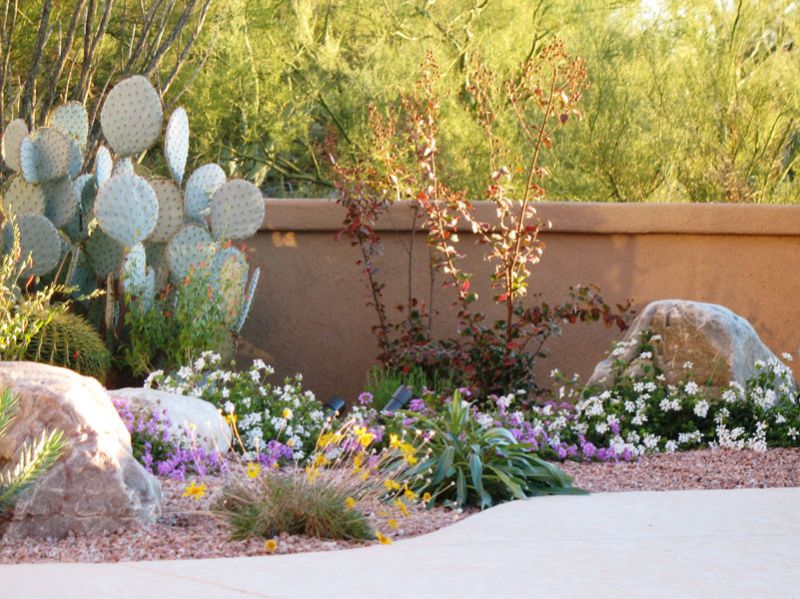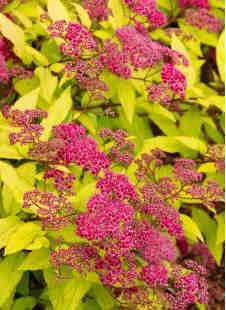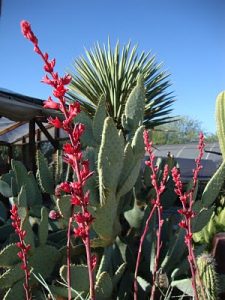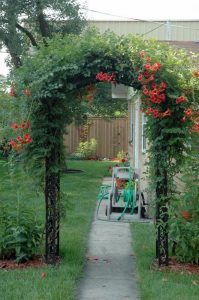 Wouldn’t it be wonderful if you could enjoy an attractive, colorful garden without spending all of your free time working at it? It can be done, and all it takes is some knowledge about the right plants to use and employing a few simple tips and techniques for easy care landscaping. A little homework before you plant will pay off in time and money spent, both now and into the future.
Wouldn’t it be wonderful if you could enjoy an attractive, colorful garden without spending all of your free time working at it? It can be done, and all it takes is some knowledge about the right plants to use and employing a few simple tips and techniques for easy care landscaping. A little homework before you plant will pay off in time and money spent, both now and into the future.
4 Low Care Principles – The principles listed will help you reach your goal of an attractive, low maintenance garden.
1.) Choose plants that are known to be reliable and problem free for your area, and varieties that won’t outgrow the space you’ve allotted to them.
Considering the bewildering array of plants available at the garden center right now, choosing the best for your needs will require a little guidance. Start by making a list of plants you like. With camera phone in hand look around the neighborhood and photograph plants that appeal to you. Take along the pictures when you ask your favorite garden expert for proper identification. Consult gardening books, magazine articles, and the web to learn about the plants on your list. Enlist the help at a garden center to learn how well local conditions suit each plant.
A common mistake is to choose plants that look just right on planting day, and then rapidly outgrow their spaces, creating a continual maintenance headache. Unlike an interior design that looks best the day it is installed, a landscape design should look its best several years later.
 Look for compact varieties of plants. For instance, many traditional favorites, such as spirea, spruce, and butterfly bush are now available in compact forms that are much more likely to suit the scale of today’s smaller gardens. Most often these plants have parts of their names in single quotes, and are referred to as “named varieties”. Examples of some named, compact plants are ‘Goldflame‘ spirea, dwarf ‘Serbian’ spruce, ‘Indigo Blue’ butterfly bush, and dwarf ‘Yetti’ hawthorn.
Look for compact varieties of plants. For instance, many traditional favorites, such as spirea, spruce, and butterfly bush are now available in compact forms that are much more likely to suit the scale of today’s smaller gardens. Most often these plants have parts of their names in single quotes, and are referred to as “named varieties”. Examples of some named, compact plants are ‘Goldflame‘ spirea, dwarf ‘Serbian’ spruce, ‘Indigo Blue’ butterfly bush, and dwarf ‘Yetti’ hawthorn.
Named varieties offer resistance to pests and diseases that plague the common species. Examples include ‘Prairifire‘ crab-apple which is resistant to both apple scab and fire blight, and ‘Knockout‘ rose which is rarely troubled by powdery mildew, a common rose disease. Choosing disease resistant varieties will result in fewer pests, which ultimately translates into lower maintenance and less care.
Some dwarf conifers, such as ‘Globe’ spruce, grow very slowly, as little as one inch per year. Such slow growers are more expensive initially because a plant that is only 4 to 6 feet tall may be 10 to 15 years old. Growers have invested as much time and materials in these as in plants that are much larger. The initial extra cost pays off over time because such plants need minimal if any pruning.
2.) Prepare the soil well before planting so plants get a strong start.
Mulch is a very effective weed deterrent. Spread a 2-3” inch layer of shredded cedar bark around plants. Cedar bark, as opposed to nuggets, chips, or additional rock provides the best coverage and, in my opinion, looks the best. As mulch breaks down it adds organic matter to the soil; it also shades roots in summer and acts as insulation in winter. I put down a fresh layer of mulch each spring with a light top dressing at the beginning of the season.
3.) Mulch and use soil moistening polymers to reduce weeds and conserve soil moisture.
 Reduce water usage by amending your plants’ soil with my specially formulated ‘Aqua Boost Crystals’. These mycorrhizal infused crystals hold 200-300 times their weight in water and keep the soil moist at the root zone of each plant. The mycorrhiza fungi added to this formula infuse the soil and encourage plants to root deeply into the soil. These crystals are so effective that plants’ demands for water can be cut in half . . . or more.
Reduce water usage by amending your plants’ soil with my specially formulated ‘Aqua Boost Crystals’. These mycorrhizal infused crystals hold 200-300 times their weight in water and keep the soil moist at the root zone of each plant. The mycorrhiza fungi added to this formula infuse the soil and encourage plants to root deeply into the soil. These crystals are so effective that plants’ demands for water can be cut in half . . . or more.
4.) Use an automatic clock to run your drip irrigation lines.
Even for plants requiring only minimal water, a drip-irrigation system on a timer eliminates standing in the yard with a hose to water plants. Since drip irrigation delivers most of its water underground, it really cuts down on the amount of water used and on weed growth, particularly during the dry summer months.
~~ ~~ ~~ ~~ ~~ ~~ ~~
 A Notable Low Care Plant is the ‘Brakelights Red’ yucca. Vibrant, brake light red blooms tower above this improved variety. This compact new selection rarely produces the ugly seedpods found on other yuccas; the result is more prolific flowering over an exceptionally long season. No other yucca blooms like this one does. For a dramatic effect plant it en masse in xeriscapes and other water wise gardens. This bountiful bloomer thrives with little to no care.
A Notable Low Care Plant is the ‘Brakelights Red’ yucca. Vibrant, brake light red blooms tower above this improved variety. This compact new selection rarely produces the ugly seedpods found on other yuccas; the result is more prolific flowering over an exceptionally long season. No other yucca blooms like this one does. For a dramatic effect plant it en masse in xeriscapes and other water wise gardens. This bountiful bloomer thrives with little to no care.
Many more low care planting ideas are available by asking for my list of ‘Mountain Friendly Plants’ the next time you visit the garden center. Regular readers of this column know that it’s free for the asking.
~~ ~~ ~~ ~~ ~~ ~~ ~~
 Plant of the Week is the ‘Balboa Sunset’ Trumpet Vine. Huge clusters of 4” flowers are deeper colored than any other vine. Taylor made for climbing quickly with colorful coverage that masks unattractive wire fences and outbuildings. Snake it up posts or columns to overhead gateways and entries. Drape over courtyard walls or let it cascade off retaining block. An excellent blooming ground cover for erosion control. Add to wildlife friendly settings where hummingbirds find it absolutely irresistible.
Plant of the Week is the ‘Balboa Sunset’ Trumpet Vine. Huge clusters of 4” flowers are deeper colored than any other vine. Taylor made for climbing quickly with colorful coverage that masks unattractive wire fences and outbuildings. Snake it up posts or columns to overhead gateways and entries. Drape over courtyard walls or let it cascade off retaining block. An excellent blooming ground cover for erosion control. Add to wildlife friendly settings where hummingbirds find it absolutely irresistible.
~~ ~~ ~~ ~~ ~~ ~~ ~~
Free Gardening Classes – The summer class schedule has been posted and starts today, Saturday, June 15 @ 9:30 a.m. Today’s free class is entitled “Bountiful Vegetable Gardens Sure to Produce”. On June 22 students will learn how to create “Containers that Bloom like Crazy”. Check out the entire summer class schedule at www.wattersgardencenter.com/category/classes.
Until next week, I’ll see you in the garden center.

